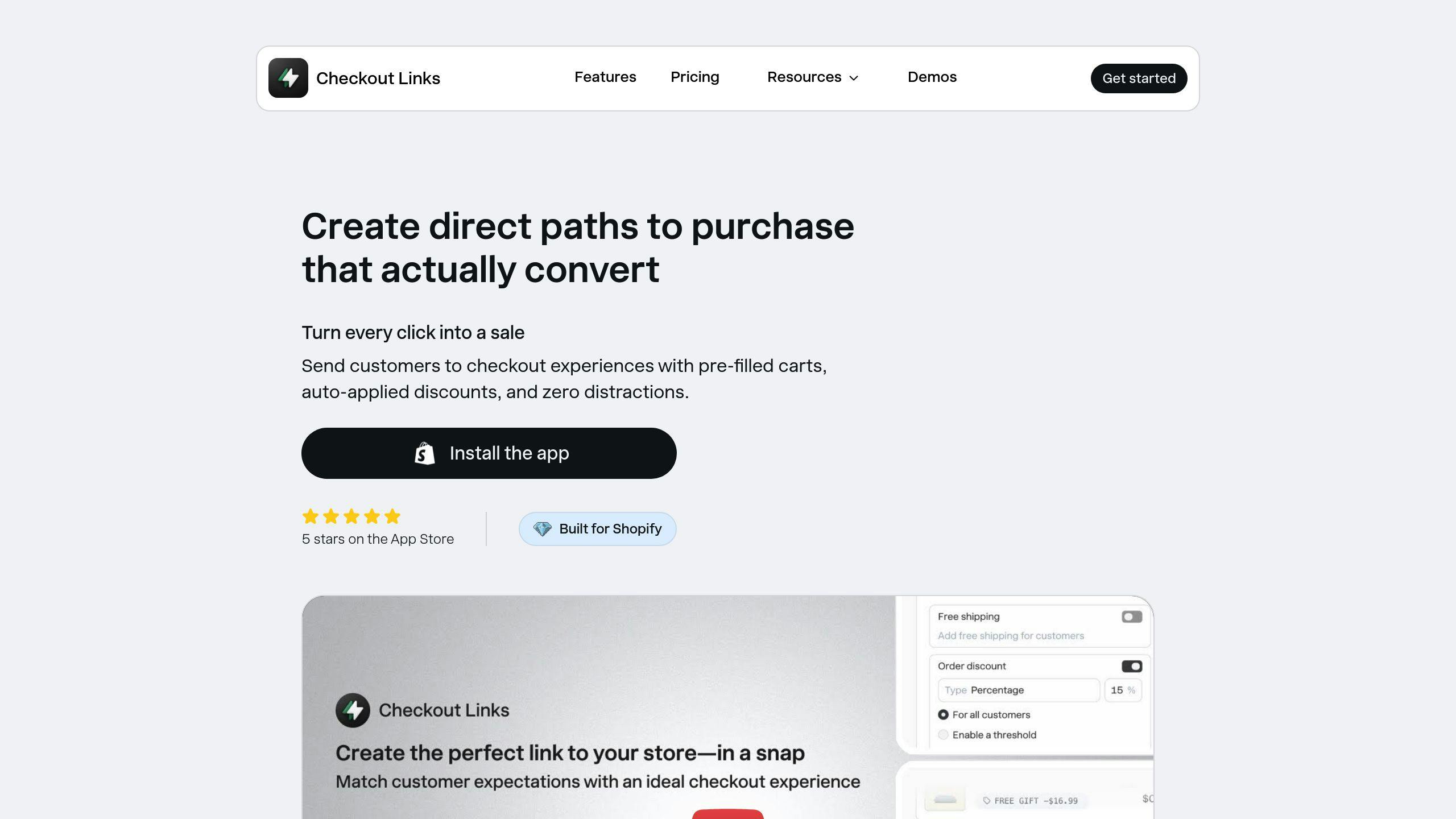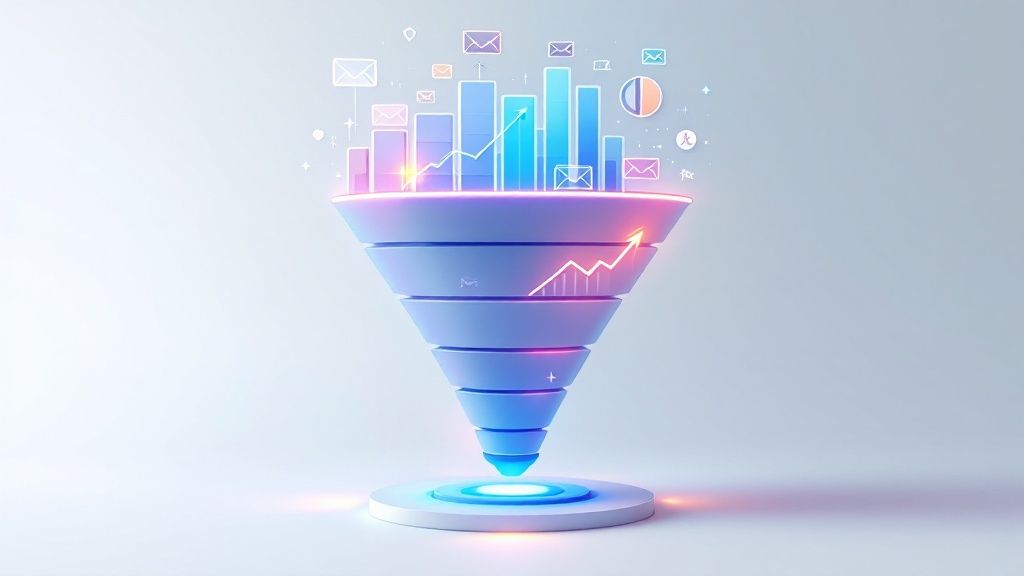Best Practices for Subscription Analytics
November 13, 2024

Subscription analytics is crucial for Shopify store owners in the subscription economy. Here’s what you need to know:
-
Key metrics to track:
- Monthly Recurring Revenue (MRR)
- Customer Lifetime Value (CLV)
- Churn Rate
-
Data collection methods:
- Use Shopify Analytics
- Set up order tag mapping
- Try specialized tools like Littledata
-
Advanced techniques:
- Future trend analysis
- Customer segmentation
- A/B testing
-
Tools to boost analytics:
- Checkout Links for Shopify for better tracking
-
Benchmarks:
- Median churn rate: 4.4%
- Median trial conversion rate: 32.2%
Related video from YouTube
Subscription Analytics Basics
Subscription analytics are key for Shopify store owners in the subscription economy. Let’s look at the main metrics and how to track them.
Main Metrics to Watch
Three metrics matter most for your subscription business:
1. Monthly Recurring Revenue (MRR)
This is your predictable monthly income from active subscribers. It’s the core of your subscription business.
2. Customer Lifetime Value (CLV)
CLV shows how much a subscriber might spend with you over time. It helps you see the big picture of customer value.
3. Churn Rate
This is the percentage of subscribers who cancel. Lower churn means better retention and a healthier business.
Here’s why these metrics matter:
MRR helps you plan for the future. If your MRR jumps from $10,000 to $15,000 in three months, you can expect more growth and plan accordingly.
CLV guides your spending on getting new customers. If your average CLV is $500, you might be okay spending $100 to get a new customer.
Churn Rate can quickly eat into your MRR. For consumer goods and subscription boxes, 10% is average. If you’re higher, it’s time to find out why and fix it.
"These metrics are key to growing your subscription business." – Industry Expert
How to Collect Data
Good data is the foundation of subscription analytics. Here’s how to gather it:
1. Use Shopify Analytics
Shopify’s built-in tools give you basic reports on sales, conversion rates, and returning customers.
2. Set Up Order Tag Mapping
This lets you separate subscription and non-subscription purchases in your analysis.
3. Try Specialized Tools
Tools like Littledata can ensure your data is 100% accurate, fixing common issues between Shopify orders and Google Analytics.
4. Watch Sign-ups and Churns
Keep an eye on new subscriptions vs. cancellations compared to your total web visits.
5. Use Checkout Links
Checkout Links for Shopify can show you how well your checkout process works. Features like pre-filled carts can help you see which marketing campaigns drive subscriptions.
Key Numbers to Monitor
Let’s talk about the numbers that really matter for your subscription business. These metrics will help you understand how you’re doing and make smart choices.
Money Metrics
These numbers show you the financial health of your business:
- Monthly Recurring Revenue (MRR): This is the money you can count on each month from your active subscriptions. It’s the heartbeat of your business.
- Annual Recurring Revenue (ARR): If you offer yearly subscriptions, ARR gives you the big picture. It’s just your MRR times 12.
- Average Revenue Per User (ARPU): This tells you how much each subscriber is worth, on average.
Here’s a real-world example:
Let’s say you run a coffee subscription box. You’ve got 1,000 subscribers – 800 pay $20/month, and 200 pay $30/month for a premium box. Here’s how it breaks down:
- MRR = (800 * $20) + (200 * $30) = $22,000
- ARR = $22,000 * 12 = $264,000
- ARPU = $22,000 / 1,000 = $22
Keep an eye on these numbers over time. If your ARPU is going up, it might mean your upselling is working or more people are choosing your pricier options.
Customer Success Metrics
These metrics help you understand your customers and predict how your business will do in the future:
- Customer Lifetime Value (CLV): This is how much a customer is worth to you over their entire relationship with your business. A higher CLV means you can spend more to get and keep customers.
- Customer Acquisition Cost (CAC): This is how much it costs you to get a new customer. You want this to be low compared to your CLV.
- Churn Rate: This is the percentage of customers who cancel their subscriptions. It shows you how happy your customers are and how much they value your product.
Let’s look at some real-world numbers:
"B2B SaaS companies usually see a churn rate of 4-5% most months. For B2C SaaS companies, it’s around 7% per month."
These numbers can give you an idea of what’s normal, but remember, every business is different.
Take Netflix, for example:
"Netflix has one of the lowest churn rates in streaming. Only about 3.5% of customers leave each month, meaning over 96% stick around."
Here’s how to use these metrics:
- Watch your CLV to CAC ratio: Aim for 3:1. You want each customer to be worth at least three times what it cost to get them.
- Keep a close eye on churn: If it starts going up, ask why. Is there a problem with your product? Are you bringing in the right customers?
- Use cohort analysis: Group your customers (maybe by when they signed up) and watch how they behave over time. This can show you which groups are most likely to cancel or upgrade.
Taking Analytics Further
As your subscription business grows, you’ll need to dig deeper into your data. Let’s explore some advanced analytics techniques that can give you an edge.
Future Trend Analysis
Predicting future trends is key for staying ahead in the subscription economy. Here’s how to use your data to forecast customer behavior and subscription patterns:
Cohort Analysis: Group customers based on when they subscribed and track their behavior over time. This can uncover patterns in retention and churn you might otherwise miss.
Spotify uses cohort analysis to understand how platform engagement changes over a user’s lifetime. They found that users who create playlists in their first week are more likely to stick around. This led to targeted onboarding campaigns that encourage playlist creation.
Predictive Modeling: Use machine learning to forecast future customer behavior. This can help you spot at-risk customers before they leave.
Netflix is a pro at this. They use predictive analytics not just for content recommendations, but also to predict when a user might cancel. If a user’s viewing habits suddenly change, Netflix might show them a personalized selection of new shows to get them watching again.
"Good subscription analytics can make or break businesses like yours." – Recurly Author
Seasonal Trend Analysis: Look for patterns in your data tied to specific times of the year. This helps you prepare for busy periods or potential engagement dips.
Fitness app Strava noticed a surge in new subscriptions every January due to New Year’s resolutions. They now run targeted campaigns in December to tap into this trend, boosting new year sign-ups by 20%.
Customer Groups
Splitting your customers into groups can lead to better marketing and higher retention. Here’s how:
Behavioral Segmentation: Group customers based on how they use your product. This helps you tailor your offerings and messages to different user types.
Grammarly segments users based on their writing style and frequency. They send different writing tips to casual users versus power users, which bumped up user engagement by 15%.
Value-Based Segmentation: Group customers based on their lifetime value or potential value to your business.
Salesforce uses this to identify high-value customers who might want additional services or premium features. This strategy has helped them increase their average revenue per user by 12% year-over-year.
Engagement-Level Segmentation: Split customers based on how often they use your product.
Duolingo groups users into "daily streakers", "casual learners", and "lapsed users." They send different motivational messages to each group, helping them achieve a 55% retention rate after one year.
The key to effective customer grouping? Use the insights you gain to give more value to your customers. As you dive into your analytics, always keep the customer experience front and center.
Checkout Links for Shopify: Better Checkout Tracking

Want to supercharge your subscription analytics? Enter Checkout Links for Shopify.
This tool lets you create custom checkout links, cart links, and landing pages for your marketing campaigns. It’s like giving your analytics a pair of super-powered glasses.
Here’s how Checkout Links can take your subscription analytics to the next level:
1. Pinpoint Your Best Channels
Create unique links for each marketing campaign. Now you’ll know exactly which channels are subscription goldmines. No more guessing where to spend your marketing dollars.
2. Boost Your Conversion Rates
Pre-filled carts? Check. Auto-applied discounts? You bet. These features can slash checkout friction and pump up your conversion rates. A/B test different setups to find your conversion sweet spot.
3. Peek Into Customer Behavior
Checkout Links plays nice with Shopify, giving you a front-row seat to customer behavior during checkout. Spot those pesky drop-off points and smooth out your subscription funnel.
4. Bridge the Offline-Online Gap
Got QR codes? Checkout Links does. Now you can track how your offline marketing efforts translate to online subscriptions. It’s like having x-ray vision for your marketing.
5. Get Personal
Dynamic links let you tailor the checkout experience. Different customer segments? Different promos? No problem. This personalization can boost conversions and give you richer data to chew on.
Checkout Links for Shopify isn’t just about optimizing checkouts. It’s about arming you with data to make smarter decisions about pricing, products, and keeping your subscribers happy.
So, ready to give your subscription analytics a turbo boost?
Making Things Better
You’ve got your subscription analytics down. Now it’s time to put that data to work. Let’s dive into A/B testing and performance benchmarking to boost your subscription program.
Testing What Works
A/B testing isn’t about guessing – it’s about knowing. It’s your tool to boost sales and improve customer experience.
Small Changes, Big Wins
Even tiny tweaks can make a huge difference. Take BestSelf Co., for example. They were struggling with a high bounce rate on their product page. After some digging, they suspected the headline was the problem. So, they tested two new versions. The result? Their winning headline bumped up conversions by 27%.
Think Outside the Box
Don’t just test headlines or button colors. Here are some other areas where A/B testing can shine:
- Pricing: Recurly found that conversion rates stayed the same between $2.99/month and $7.99/month subscriptions. This kind of insight could save you from leaving money on the table.
- Free Trial Length: On average, free trials last 15.6 days. But Consumer Goods & Retail companies often go for a full month (28.7 days). Test different lengths to find what works for you.
- Paywall Frequency: In Canada, showing the paywall twice led to a 76% conversion rate. In the US, five times hit 85%, while in the UK, six times reached 71%. Your magic number might be different, so test it out.
Personalization Pays Off
Netflix is the A/B testing champ. They use it to tailor user experiences based on individual viewing habits. They test everything from show thumbnails to descriptions, always fine-tuning their recommendations to keep subscribers hooked.
Comparing Performance
To really excel, you need to know how you stack up. Here’s how to measure your results:
Check Your Numbers
Compare your key metrics to industry standards:
- Churn Rate: The median across subscription businesses is 4.4%. For Consumer Goods & Retail, aim to beat 7.1%. In Education, shoot for under 6.6%.
- Trial Conversion Rate: The median is 32.2%. Business & Professional Services lead with 39.5%. How do you measure up?
- Free Trial Offering: 66% of subscription businesses offer a free trial. If you’re not, you might be missing out.
Learn from the Best
See what top performers are doing:
- Keeping Subscribers: Recurly saved 72% of at-risk subscribers using recovery events and $254 million through dunning management.
- Flexibility: 39.7% of merchants on Recurly let subscribers pause their plans, preventing over 400,000 cancellations. Could this work for you?
Keep Pushing Forward
What works today might not work tomorrow. The subscription world is always changing. As Nyaima Smith-Taylor, a Conversion Copywriter, puts it:
"Your business may see hopeful spikes of success, but they will quickly turn into ‘Spikes of Nope’ if you don’t have a formal way of experimenting, tracking, and replicating what works and what doesn’t."
So keep testing, keep measuring, and keep improving. Your subscription business depends on it.
Summary
Let’s recap how to boost your Shopify store with subscription analytics:
Focus on Key Metrics
Don’t drown in data. Zero in on these:
- Monthly Recurring Revenue (MRR)
- Customer Lifetime Value (CLV)
- Churn Rate
The median churn rate for subscription businesses is 4.4%. For Consumer Goods & Retail, aim to beat 7.1%.
Use Data Wisely
Grab accurate data with Shopify Analytics and specialized tools. Littledata can sync Shopify orders and Google Analytics with 100% accuracy.
Segment and Personalize
Group customers by behavior, value, or engagement. Netflix’s personalization strategy helps them keep their monthly churn rate at just 3.5%.
Test and Optimize
A/B test everything – pricing, free trial length, even paywall frequency. BestSelf Co. bumped conversions 27% by tweaking their headline.
Benchmark Your Performance
How do you stack up? The median trial conversion rate is 32.2%.
Use Advanced Tools
Try Checkout Links for Shopify to create custom checkout links and track your marketing campaigns better.
Keep Customers Happy
A 5% boost in customer retention can increase profits by up to 95%. Try flexible subscription management to keep subscribers around.
Stay Flexible
The subscription world changes fast. Keep testing and improving. As Nyaima Smith-Taylor, a Conversion Copywriter, says:
"Your business may see hopeful spikes of success, but they will quickly turn into ‘Spikes of Nope’ if you don’t have a formal way of experimenting, tracking, and replicating what works and what doesn’t."
FAQs
What is subscription analytics?
Subscription analytics is how businesses track and make sense of data from their subscription services. It’s all about measuring things that matter, like:
- How many people are subscribing
- How much money each order brings in
- How many customers are leaving
- How much money comes in each month
- How much a customer is worth over time
This info helps companies figure out how they’re doing and make smart choices to grow. With more businesses using subscription models, analytics has become a big deal.
Here’s a cool fact: Zuora, a company that helps manage subscriptions, found that businesses using advanced analytics kept 30% more customers and grew their monthly income 20% faster than those who didn’t.
"Without analytics, running a SaaS business would be like driving with your eyes closed. You’d have no idea where you’re going." – Industry Expert
But subscription analytics isn’t just about boring reports. It helps businesses do some pretty neat stuff:
1. See the future (kind of):
By looking at past data, companies can guess what subscribers might do next and plan for it.
2. Get pricing just right:
They can figure out which prices work best to get new customers and keep the ones they have.
3. Keep customers happy:
By spotting who might leave before they do, companies can step in and try to keep them around.
4. Make things personal:
When you know what different groups of subscribers like, you can give them exactly what they want.
 Checkout Links
Checkout Links



